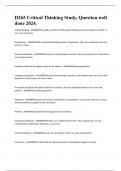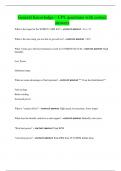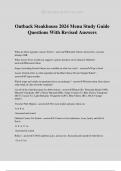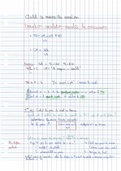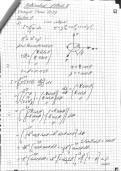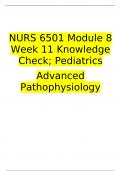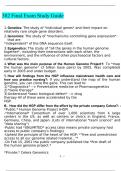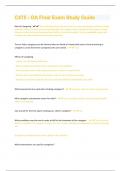CVEN2401 (Transport
Engineering) Study Notes
Introduction to Transport Planning
THE ROLE OF TRANSPORT
• Provides necessary connectivity between people and places
• Greater worldwide transport has also facilitated the spread of infectious
diseases
• Efficiently satisfies the mobility of a population
HISTORY OF TRANSPORT SYSTEMS
• The technological evolution of the human race has closely followed the
advancement of transport systems
• In early history, cities were usually established in locations with high
water-based transport options
• Later on, cities could be created along highway routes or railway
lines
• In the past century, cities have grown into metropolises; sparking the
need for ring-roads which facilitate trans-metropolitan mobility
ENTITIES INVOLVED IN TRANSPORT PLANNING
• City planning departments are concerned with housing and urban
transport
• Traffic engineering departments are involved with the efficient and safe
operation of urban transport networks
• State highway departments contribute to the connectivity of interstate
roadways
• Federal transport departments operate and build interstate highway
networks
INCREASED TRAVEL DEMAND OVER TIME
• Demand for transport is proportional to population
• The problems arising from greater transport demand:
o Increase in car ownership has led to higher rates of obesity
o Rising traffic congestion causes a decrease in productivity,
leisure time and total utility
o The increase in fuel prices has caused a decrease in economic
performance and savings for commuters
o Drastically increased vehicle pollution and smog has sparked a
rise in health issues in large cities
TRANSPORT SYSTEM COMPONENTS
• Fixed facilities are the components of the transport infrastructure that
remain in place such as roads, railway segments and water pipes
, • Flow entities are the actual vehicles that move around the transport
network such as cars and trains
o Private (i.e. car, Uber, bicycle)
o Public (i.e. bus, aeroplane)
• Flow control systems directly affect the flow throughout a transport
system and include traffic signals and signage
TRANSPORT SUPPLY AND DEMAND
• Transport demand is derived from:
o Demand for imports and exports via freight
o Level of employment
o Presence of retail stores
o Population
o Modes of transport available
o Economic standing
o Geography
• Transport supply includes:
o Transport infrastructure
o Available vehicles
o Services
• The effectiveness of the transport network can be evaluated via:
o Travel time
o Generalised cost (time value)
o Reliability
o Environmental impact
o Energy consumption
TYPES OF TRANSPORT MODELS
• Macroscopic models are large-scale representations of the
interactions between passages across an entire city
• Microscopic models are investigations into the behaviour of single
intersections or road stretches
• Mesoscopic models are representations of traffic flows within small
precincts or suburbs
NETWORK TERMINOLOGY
• A node is a location associated with travel demand and could include
intersections, bus terminals or railway interchanges
• A link is a passage that connects two or more nodes, such as a
roadway or railway that can be associated with congestion levels
• The four-step travel demand model involves the following processes:
o Trip Generation: Calculating the number of trips required
o Trip Distribution: Organizing the origin and destination of each
trip
o Mode Split: Determining the mode of transport to be utilised
o Trip Assignment: Calculating the route of travel from origin to
destination
Traffic Flow Theory
, ELEMENTS OF TRAFFIC FLOW
• Flow (q): Number of vehicles passing a point of roadway per unit of
time as measured in vehicles/hour
o q=N/T (Flow = Vehicles/Time)
o q=k*vs (Flow = Density*Space Mean Velocity)
o Measured in real life with loop detectors, pneumatic tube counts
and video surveying
• Density (k): The number of vehicles present in a given space of road at
a given time as measured in vehicles/km
o k=N/L (Density = Vehicles/Length)
• Speed (v): Distance travelled by a vehicle divided by a given time
frame, measured in km/hour
• Spacing (s): The distance between two consecutive vehicles on a
roadway, measured in metres
• Headway (h): The time length between two consecutive vehicles on a
roadway, measured in seconds
TIME-DISTANCE FLOW DIAGRAMS
• Time is plotted on the x-axis against distance travelled (along a
roadway) on the y-axis
• Every vehicle travelling along the roadway is plotted as a separate line
on the graph
• The slope of each line (dx/dt) represents the speed of the vehicle
• Spacing is a vertical measurement upon the graph, whereas headway
is a horizontal reading
• The crossing over of two lines of the graph represents a vehicle
overtake
RELATIONSHIPS BETWEEN TRAFFIC ELEMENTS
• As speed increases, the safe spacing gap increases which decreases
traffic density
• Flow has a parabolic relationship to velocity as follows:
• Certain definitions for flow-density diagrams:
o Jam density is the traffic density at which no flow can occur
(complete blockage)
o Capacity is the maximum flow on the flow density diagram
o Free-flow speed is the velocity associated with the maximum
flow on the flow-density diagram
Engineering) Study Notes
Introduction to Transport Planning
THE ROLE OF TRANSPORT
• Provides necessary connectivity between people and places
• Greater worldwide transport has also facilitated the spread of infectious
diseases
• Efficiently satisfies the mobility of a population
HISTORY OF TRANSPORT SYSTEMS
• The technological evolution of the human race has closely followed the
advancement of transport systems
• In early history, cities were usually established in locations with high
water-based transport options
• Later on, cities could be created along highway routes or railway
lines
• In the past century, cities have grown into metropolises; sparking the
need for ring-roads which facilitate trans-metropolitan mobility
ENTITIES INVOLVED IN TRANSPORT PLANNING
• City planning departments are concerned with housing and urban
transport
• Traffic engineering departments are involved with the efficient and safe
operation of urban transport networks
• State highway departments contribute to the connectivity of interstate
roadways
• Federal transport departments operate and build interstate highway
networks
INCREASED TRAVEL DEMAND OVER TIME
• Demand for transport is proportional to population
• The problems arising from greater transport demand:
o Increase in car ownership has led to higher rates of obesity
o Rising traffic congestion causes a decrease in productivity,
leisure time and total utility
o The increase in fuel prices has caused a decrease in economic
performance and savings for commuters
o Drastically increased vehicle pollution and smog has sparked a
rise in health issues in large cities
TRANSPORT SYSTEM COMPONENTS
• Fixed facilities are the components of the transport infrastructure that
remain in place such as roads, railway segments and water pipes
, • Flow entities are the actual vehicles that move around the transport
network such as cars and trains
o Private (i.e. car, Uber, bicycle)
o Public (i.e. bus, aeroplane)
• Flow control systems directly affect the flow throughout a transport
system and include traffic signals and signage
TRANSPORT SUPPLY AND DEMAND
• Transport demand is derived from:
o Demand for imports and exports via freight
o Level of employment
o Presence of retail stores
o Population
o Modes of transport available
o Economic standing
o Geography
• Transport supply includes:
o Transport infrastructure
o Available vehicles
o Services
• The effectiveness of the transport network can be evaluated via:
o Travel time
o Generalised cost (time value)
o Reliability
o Environmental impact
o Energy consumption
TYPES OF TRANSPORT MODELS
• Macroscopic models are large-scale representations of the
interactions between passages across an entire city
• Microscopic models are investigations into the behaviour of single
intersections or road stretches
• Mesoscopic models are representations of traffic flows within small
precincts or suburbs
NETWORK TERMINOLOGY
• A node is a location associated with travel demand and could include
intersections, bus terminals or railway interchanges
• A link is a passage that connects two or more nodes, such as a
roadway or railway that can be associated with congestion levels
• The four-step travel demand model involves the following processes:
o Trip Generation: Calculating the number of trips required
o Trip Distribution: Organizing the origin and destination of each
trip
o Mode Split: Determining the mode of transport to be utilised
o Trip Assignment: Calculating the route of travel from origin to
destination
Traffic Flow Theory
, ELEMENTS OF TRAFFIC FLOW
• Flow (q): Number of vehicles passing a point of roadway per unit of
time as measured in vehicles/hour
o q=N/T (Flow = Vehicles/Time)
o q=k*vs (Flow = Density*Space Mean Velocity)
o Measured in real life with loop detectors, pneumatic tube counts
and video surveying
• Density (k): The number of vehicles present in a given space of road at
a given time as measured in vehicles/km
o k=N/L (Density = Vehicles/Length)
• Speed (v): Distance travelled by a vehicle divided by a given time
frame, measured in km/hour
• Spacing (s): The distance between two consecutive vehicles on a
roadway, measured in metres
• Headway (h): The time length between two consecutive vehicles on a
roadway, measured in seconds
TIME-DISTANCE FLOW DIAGRAMS
• Time is plotted on the x-axis against distance travelled (along a
roadway) on the y-axis
• Every vehicle travelling along the roadway is plotted as a separate line
on the graph
• The slope of each line (dx/dt) represents the speed of the vehicle
• Spacing is a vertical measurement upon the graph, whereas headway
is a horizontal reading
• The crossing over of two lines of the graph represents a vehicle
overtake
RELATIONSHIPS BETWEEN TRAFFIC ELEMENTS
• As speed increases, the safe spacing gap increases which decreases
traffic density
• Flow has a parabolic relationship to velocity as follows:
• Certain definitions for flow-density diagrams:
o Jam density is the traffic density at which no flow can occur
(complete blockage)
o Capacity is the maximum flow on the flow density diagram
o Free-flow speed is the velocity associated with the maximum
flow on the flow-density diagram


